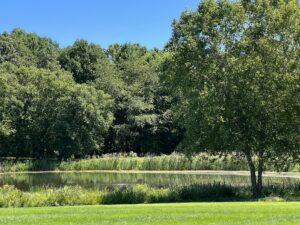
More yards have wet areas than you would think, and tree decline due to the roots having “wet feet” is becoming more common. Some wet/moist areas are naturally occurring, such as swales, low points in the grade and areas near water, and it makes sense to the home gardener that those areas may retain water.
The unseen enemy, however, is compacted soil which doesn’t drain properly. This is usually the result of heavy construction equipment repeatedly driving over or being parked on the soil. This can happen during the construction of a new home or during home improvement projects, such as building a patio, walkway or swimming pool.
Another complication is that due to climate change, the Mid-Atlantic is having longer periods of wet and dry seasons. So while we may be getting approximately the same amount of rainfall each year, that rain is falling over shorter periods of time, making flooding and saturated soil more common.
When the soil becomes saturated, the compacted soil does not drain quickly, and it can cause the tree roots to sit in water. If this happens for a prolonged period or on a regular basis, the roots will begin to rot and die. Not only will this mean that the roots cannot provide nutrition to the tree, it also means that the tree can become unstable and be prone to falling, especially during high winds.
There are easy ways to determine if you have compacted soil. Notice any areas in the lawn that are “squishy” after it rains. The squishiness indicates a drainage problem. A more accurate way of knowing whether you have a problem is to do a simple perk test. Dig a hole 18” deep and fill it with water. Let it drain and fill it with water again. The water should drain fairly quickly, within an hour or so. If it doesn’t there is a drainage problem.
Fortunately, there are beautiful trees that are well adapted to tolerate moist or even wet soil. It is important to understand, however, that planting trees will not correct a drainage problem.
Trees that Tolerate Moist Areas
- Black Gum
- Dawn Redwood
- Eastern Red Cedar
- Pin Oak
- Red Maples (such as October Glory, Red Sunset, Autumn Blaze)
- Sweet Gum
- Tulip Poplar
- Willow Oak
Trees that Tolerate Wet Areas
- American Sycamore
- Bald Cypress
- London Planetree
- River Birch
- Serviceberry
- Swamp White Oak
- Sweetbay Magnolia
- Weeping Willow
